Abstract
Three basic trends in the development of acoustic communication in Tettigonioidea are distinguished. The first one is observed in predatory tettigoniids and conocephalids. It is associated with the improvement of the territorial behavior and results in the appearance of territorial, aggressive and protest sounds (only males stridulate) in the acoustic repertoire. The second trend is caused by the development of defensive mechanisms. It is observed in phytophagous katydids belonging to the family Bradyporidae dwelling in deserts and other exposed habitats. As a rule, their acoustic repertoire includes long-lasting calling songs and disturbance (protest) sounds; rather often, these sounds are produced both by males and females. The unmasking effect of signals is compensated for by specific defense adaptations. The third evolutionary tendency is most completely expressed in phytophagous Phaneropteridae and phytophilous Bradyporidae (Ephippigerinae) as a result of the predator press and the improvement of sexual behavior. It leads to appearance of a “slow” system of communication, when the unmasking effect of songs is minimized by the decrease in the acoustic activity of males. Females produce response signals, while males produce complex calling, courtship, and confirming sounds. The temporal pattern of a signal is one of the most reliable criteria for the discrimination of species and subspecies. It is difficult to use physical parameters of sounds as a criterion for the differentiation of taxa at the superspecies rank, since acoustical signalling is obviously a subject of evolution of the acoustic community rather than of the taxon. Parallelisms and convergences are observed in the evolution of acoustic communication systems, but complex analysis allows revealing the initial type of the acoustic system and defining the reasons for adaptive reorganizations.
Similar content being viewed by others
References
Bukhvalova, M.A. and Zhantiev, R.D., “Acoustic Signals in Locust Communities (Orthoptera, Acrididae, Gomphocerinae),” Zool. Zh. 72(9), 47–62 (1993).
Dubrovin, N.N. and Zhantiev, R.D., “Acoustic Signals of Katydids of the Family Tettigoniidae (Orthoptera),” Zool. Zh. 49(7), 1001–1014 (1970).
Heller, K.-G., “Warm-up Stridulation in the Bushcricket Hexacentrus unicolor Serville (Orthoptera, Conocephalidae, Listroscelinae),” J. Exp. Biol. 126, 97–109 (1986).
Heller, K.-G., Bioakustik der europäischen Laubheuschrecken (Verl. Josef Margraf, Weikersheim, 1988).
Korsunovskaya, O.S., Zhantiev, R.D., and Savitsky, V.Yu., “The Songs of the Palaearctic Bush Crickets of the Tribe Drymadusini (Orthoptera, Tettigoniidae),” Russian Entomol. J. 11, 335–350 (2002).
Römer, H. and Lewald, J., High-Frequency Sound Transmission in Natural Habitats: Implications for the Evolution of Insect Acoustic Communication,” Behav. Ecol. Sociobiol. 29, 437–444 (1992).
Walker, T.J. and Moore, T.E., Singing Insects of North America, http://buzz.ifas.ufl.edu/ (2000).
Walker, T.J., “The uhleri Group of the Genus Amblycorypha (Orthoptera: Tettigoniidae): Extraordinarily Complex Songs and New Species,” J. Orth. Res. 13, 169–183 (2004).
Whitesell, J.J. and Walker, T.J., “Photoperiodically Determined Dimorphic Calling Songs in a Katydid,” Nature 274, 887–888 (1978).
Zhantiev, R.D. Doctorate’s Dissertation in Biology (Moscow, Moscow University, 1979).
Zhantiev, R.D., Insect Bioacoustics (Nauka, Moscow, 1981) [in Russian].
Zhantiev, R.D. and Korsunovskaya, O.S., “Acoustic Communication in Leaf Katydids (Tettigoniidae, Phaneropterinae) of the European USSR,” Zool. Zh. 65(8), 1151–1163 (1986).
Zhantiev, R.D. and Korsunovskaya, O.S., “Acoustic Signals of the Bushcrickets of Tribe Barbitistini (Orthoptera: Tettigoniidae: Phaneropterinae) from Eastern Europe and the Caucasus: I. Poecilimon Fisch., Isoimon B.-Bienko,” Russ. Entomol. J. 14, 101–111 (2005).
Zhantiev, R.D., Korsunovskaya, O.S., and Byzov, S.D., “Acoustic Communication in Desert Grasshoppers (Bradyporidae, Deracanthinae),” Zool. Zh. 74(9), 58–72 (1995).
Author information
Authors and Affiliations
Corresponding author
Additional information
Original Russian Text © O.S. Korsunovskaya, 2009, published in Zoologicheskii Zhurnal, 2009, Vol. 88, No. 1, pp. 18–22.
Rights and permissions
About this article
Cite this article
Korsunovskaya, O.S. Acoustic signals in katydids (Orthoptera, Tettigonidae). Communication 2. Entmol. Rev. 89, 16–20 (2009). https://doi.org/10.1134/S0013873809010035
Received:
Published:
Issue Date:
DOI: https://doi.org/10.1134/S0013873809010035




